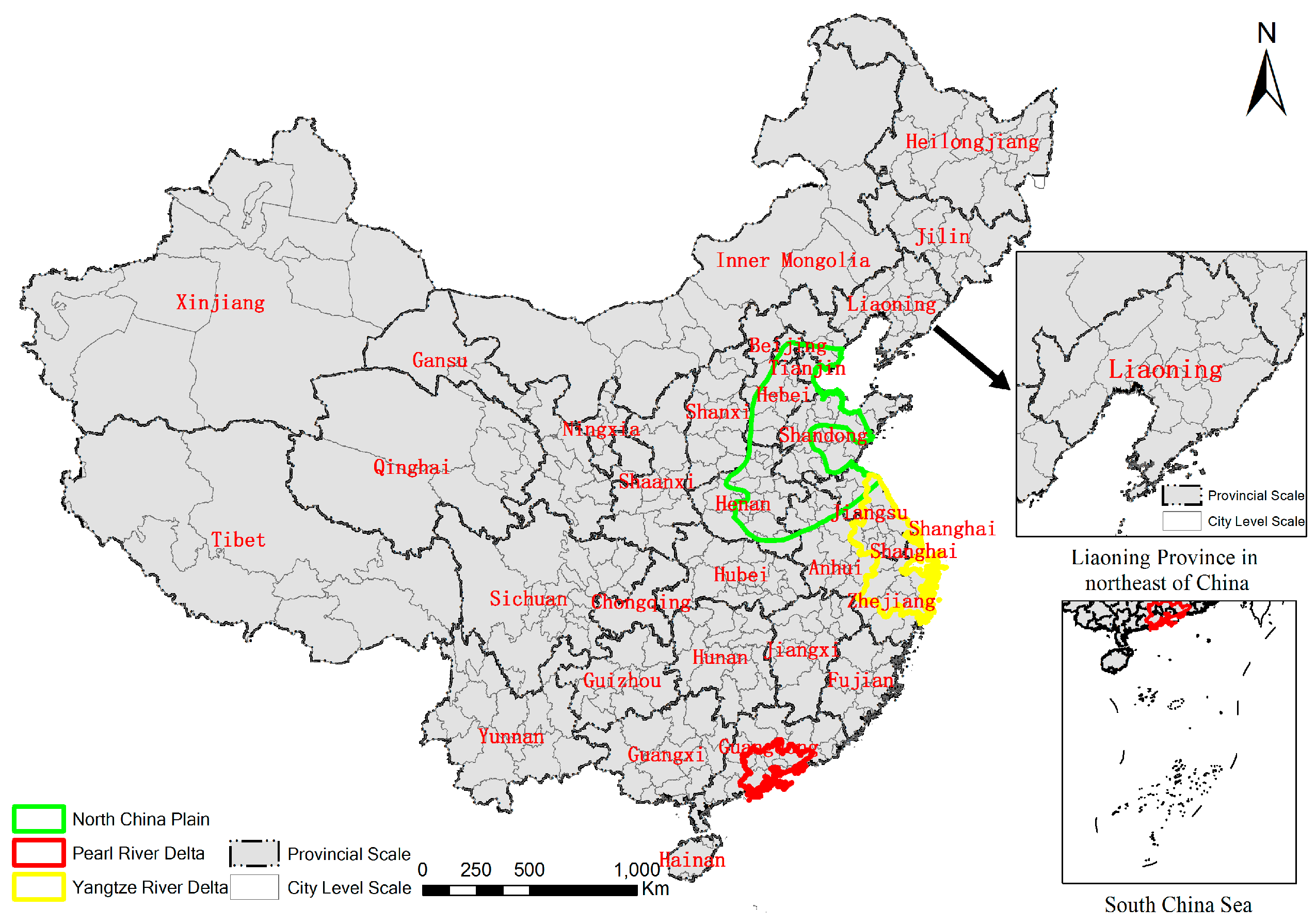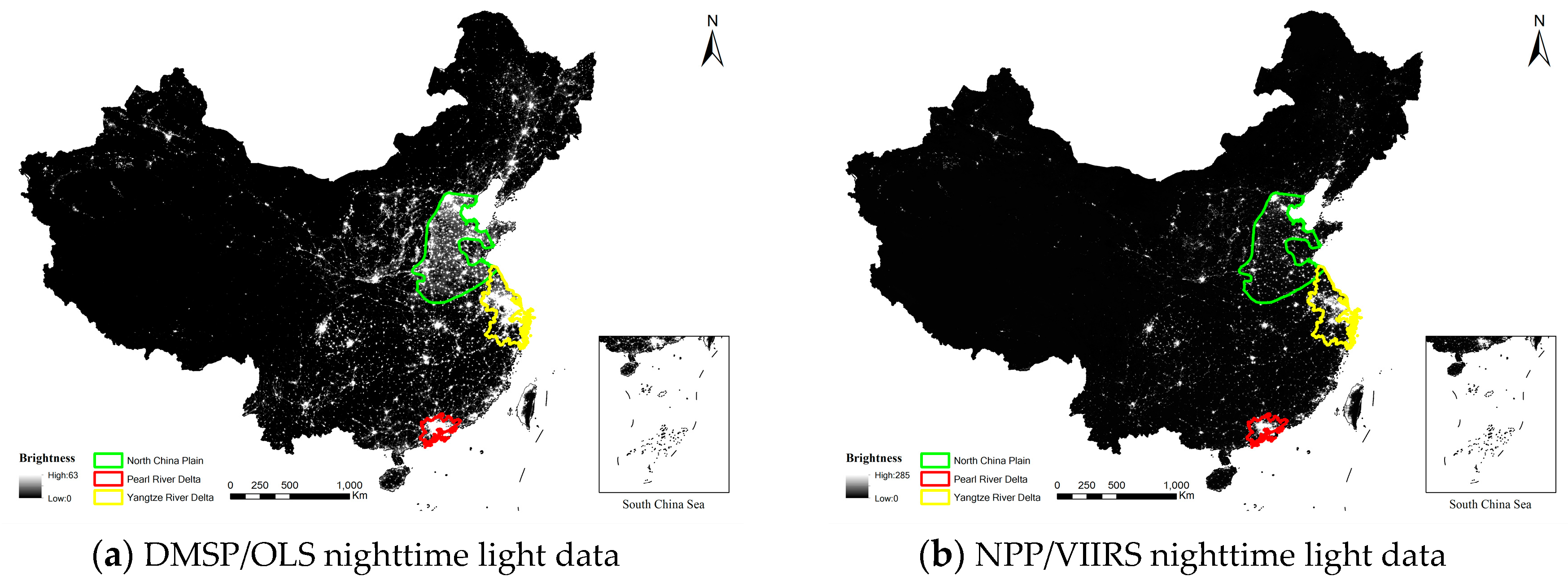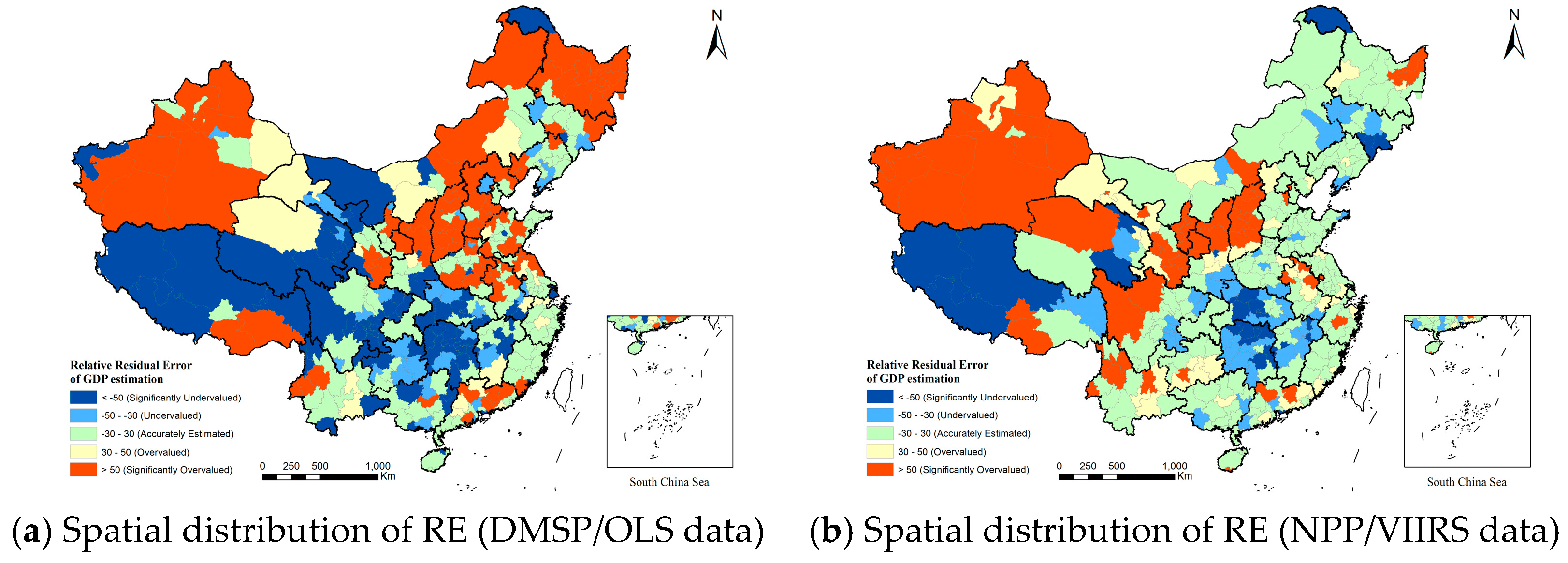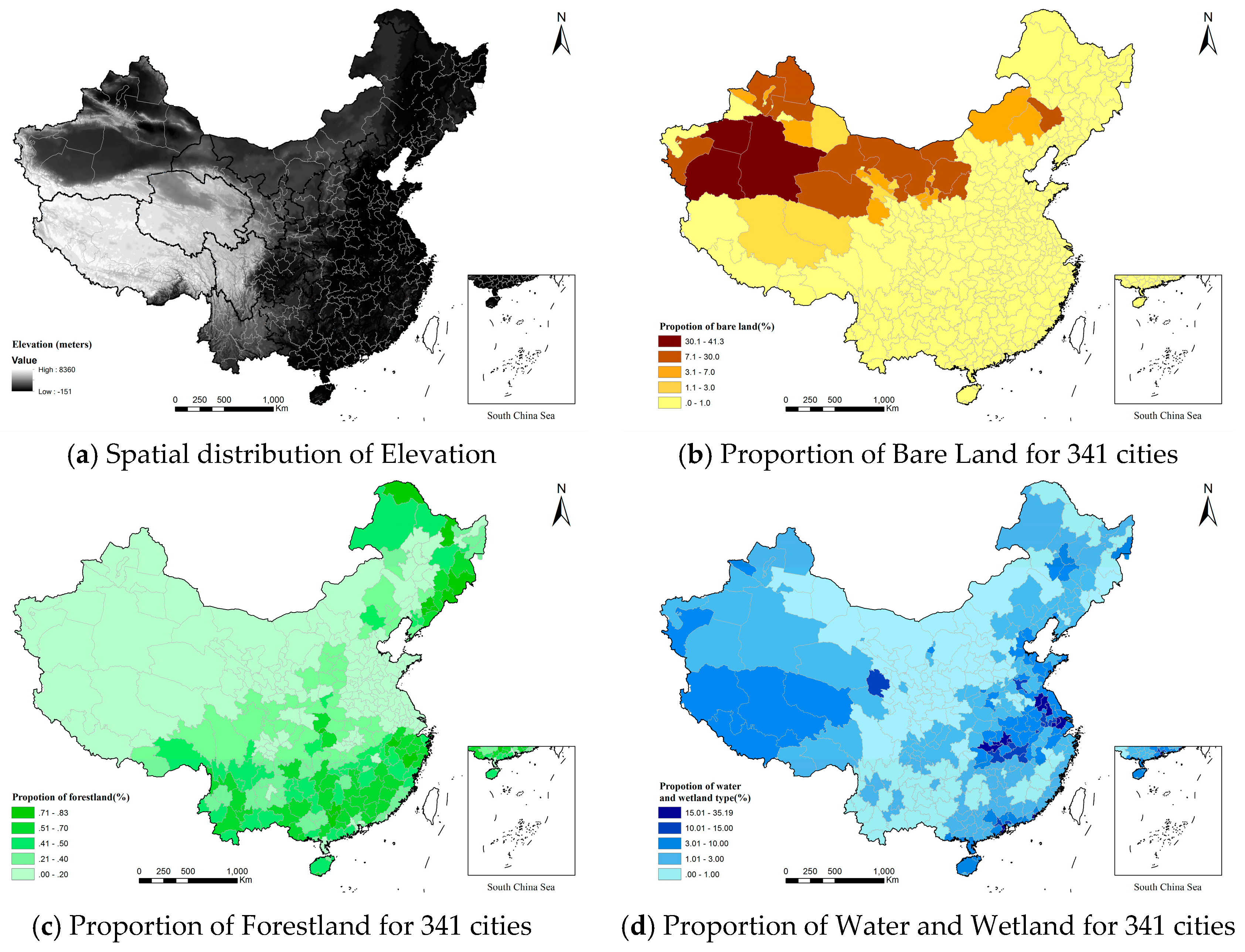The Suitability of Different Nighttime Light Data for GDP Estimation at Different Spatial Scales and Regional Levels
Abstract
:1. Introduction
2. Study Area and Data
2.1. Study Area
2.2. Data Collection
3. Methods
3.1. Correction of the NPP/VIIRS Nighttime Light Data
3.2. Simulation Model
4. Results
4.1. Nighttime Light Images
4.2. Suitability of Nighttime Light Data
4.3. Suitability of Spatial Scale
4.4. Suitability of Fitting Function Model
4.5. Suitability of Different City Regions
5. Discussion
5.1. The Influence of Nighttime Light Image Resolution and the Spatial Scales of Analysis
5.2. The Influence of Land Cover Patterns
5.3. The Influence of Regional Industrial Structures
6. Conclusions
- (1)
- DMSP/OLS nighttime light data can be used in GDP estimation at the provincial scale but may be not suitable at the city level scale. NPP/VIIRS nighttime light data are usually suitable for GDP estimation at both the provincial scale and the city-level scale.
- (2)
- For GDP estimation at the provincial scale, the results based on different models display no apparent differences. However, at the city level scale, the accuracy of GDP estimation using the exponential model and the polynomial model is better than the accuracy of GDP estimation using the linear regression model.
- (3)
- The RE values of GDP estimation in each city, based on the DMSP/OLS data, display no obvious spatial distribution pattern, but the spatial distribution of RE displays a regular pattern in each city based on the NPP/VIIRS data. Specifically, the absolute value of RE for GDP estimation gradually declines from the west to the east, which implies that it is more suitable for GDP estimation to use the NPP/VIIRS nighttime light data in the eastern part of Mainland China. However, the unified national model for GDP prediction based on the NPP/VIIRS data is usually not suitable for most of western China.
- (4)
- The GDP estimation accuracy is influenced by the spatial and radiation resolution of the nighttime light data, as well as the spatial scale, the characteristics of the terrain and landforms, the landscape, and the industrial structure of the study area. Generally, higher spatial and radiation resolutions of the nighttime light data result in better accuracy in GDP estimation. The cities with moderate to high elevations, low vegetation coverage, and large amounts of exposure surfaces often have their GDP overestimated; the cities with extremely high elevation, high vegetation coverage, or large amounts of water are prone to GDP underestimation. The cities with low economic development or with large amounts of secondary industry (especially the energy industry) are also characterized by overestimation, but in the regions where the economy mainly relies on primary industries, the GDP is usually underestimated.
Acknowledgments
Author Contributions
Conflicts of Interest
References
- Xu, K.N.; Chen, F.L.; Liu, X.Y. The truth of China Economic Growth: Evidence from Global Night-time Light Data. Econ. Res. J. 2015, 9, 17–29. (In Chinese) [Google Scholar]
- Yue, W.Z.; Gao, J.B.; Yang, X.C. Estimation of Gross Domestic Product Using Multi-Sensor Remote Sensing Data: A case study in Zhejiang Province, East China. Remote Sens. 2014, 6, 7260–7275. [Google Scholar]
- Hu, Y.F.; Wang, Q.Q.; Liu, Y.; Li, J.; Ren, W.B. Index System and Transferring Methods to build the National Society and Economy Grid Database. Geo-Inf. Sci. 2011, 13, 573–578. (In Chinese) [Google Scholar] [CrossRef]
- Mao, W.H.; Hu, D.Y.; Cao, R.; Deng, L. Monitoring urban expansion of Zhejiang Province using MODIS/EVI data products and DMSP/OLS nighttime light data. Geogr. Res. 2013, 32, 1325–1335. (In Chinese) [Google Scholar]
- Chen, X.; Nordhaus, W.D. Using Luminosity Data as a Proxy for Economic Statistics. Proc. Natl. Acad. Sci. USA 2011, 108, 8589–8594. [Google Scholar] [CrossRef] [PubMed]
- He, C.Y.; Li, J.G.; Chen, J.; Shi, P.J.; Pan, Y.Z.; Li, J.; Ichinose, T. The urbanization model and process in Bohai Sea surrounding area in the 1990s by using DMSP/OLS data. Acta Geogr. Sin. 2005, 60, 409–417. [Google Scholar]
- Li, D.R.; Li, X. An overview on data mining of nighttime light remote sensing. Acta Geod. Cartogr. Sin. 2015, 44, 591–601. (In Chinese) [Google Scholar]
- Wu, J.S.; Liu, H.; Peng, J.; Ma, L. Hierarchical structure and spatial pattern of China’s urban system: Evidence from DMSP/OLS nightlight data. Acta Geogr. Sin. 2014, 69, 759–770. [Google Scholar]
- Zhuo, L.; Li, Q.; Shi, P.J.; Chen, J.; Zheng, J.; Li, X. Identification and characteristics analysis of urban land expansion types in China in the 1990s using DMSP/OLS data. Acta Geogr. Sin. 2016, 61, 169–178. [Google Scholar]
- Zhuo, L.; Chen, J.; Shi, P.J.; Gu, Z.H.; Fan, Y.D.; Ichinose, T. Modeling population density of China in 1998 based on DMSP/OLS nighttime light image. Acta Geogr. Sin. 2005, 60, 266–276. [Google Scholar]
- Yang, X.C.; Yue, W.Z.; Gao, D.W. Spatial improvement of Human Population Distribution Based on Multi-Sensor Remote-sensing Data: An Input for Exposure Assessment. Int. J. Remote Sens. 2013, 34, 5569–5583. [Google Scholar] [CrossRef]
- Forbes, D.J. Multi-scale Analysis of the Relationship between Economic Statistics and DMSP/OLS Night Light Images. GISci. Remote Sens. 2013, 50, 483–499. [Google Scholar]
- Elvidge, C.D.; Baugh, K.E.; Kihn, E.A.; Kroehl, H.W.; Davis, E.R.; Davis, C.W. Relation between satellite observed visible near infrared emissions, population, economic activity and electric power consumption. Int. J. Remote Sens. 1997, 18, 1373–1379. [Google Scholar] [CrossRef]
- Ghost, T.; Powell, R.; Elvidge, C.D.; Baugh, K.E.; Sutton, P.C.; Anderson, S. Shedding light on the global distribution of economic activity. Open Geogr. J. 2010, 3, 148–161. [Google Scholar]
- He, C.Y.; Ma, Q.; Liu, Z.F.; Zhang, X.F. Modeling the Spatiotemporal Dynamics of Electric Power Consumption in Mainland China Using Saturation-corrected DMSP/OLS Nighttime Stable Light Data. Int. J. Digit. Earth 2014, 7, 993–1014. [Google Scholar] [CrossRef]
- Han, X.D.; Zhou, Y.; Wang, S.X.; Liu, R.; Yao, Y. GDP spatialization in China based on nighttime imagery. J. Geo-Inf. Sci. 2012, 14, 128–136. (In Chinese) [Google Scholar] [CrossRef]
- Doll, C.N.H.; Muller, J.P.; Morley, J.G. Mapping regional economic activity from night-time light satellite imagery. Ecol. Econ. 2006, 57, 75–92. [Google Scholar] [CrossRef]
- Han, X.D.; Zhou, Y.; Wang, S.X.; Liu, R.; Yao, Y. GDP spatialization in China based on DMSP/OLS data and land use data. Remote Sens. Technol. Appl. 2012, 27, 396–405. (In Chinese) [Google Scholar]
- Zhang, Q.L.; Steo, K.C. Mapping urbanization dynamics at regional and global scales using multi-temporal DMSP/OLS nighttime light data. Remote Sens. Environ. 2011, 115, 2320–2329. [Google Scholar] [CrossRef]
- Ma, T.; Zhou, C.H.; Pei, T. Quantitative estimation of urbanization dynamics using time series of DMSP/OLS nighttime light data: A comparative case study from China’s cities. Remote Sens. Environ. 2012, 124, 99–107. [Google Scholar]
- Li, X.; Xu, H.M.; Chen, X.L.; Li, C. Potential of NPP-VIIRS Nighttime Light Imagery for Modeling the Regional Economy of China. Remote Sens. 2013, 5, 3057–3081. [Google Scholar] [CrossRef]
- Liang, Y.J.; Xu, Z.M. Modeling the Spatial distribution of GDP based on night light radiation: A case study in Ganzhou district, Zhangye Municipality. J. Glaciol. Geocrol. 2013, 35, 249–254. [Google Scholar]
- Tian, Y.Z.; Yue, T.X.; Zhu, L.F.; Clinton, N. Modeling population density using land cover data. Ecol. Model. 2005, 189, 72–88. [Google Scholar] [CrossRef]
- Zandbergen, P.A.; Ignizio, D.A. Comparison of dasymetric mapping techniques for small-area population estimates. Cartogr. Geogr. Inf. Sci. 2010, 37, 199–214. [Google Scholar] [CrossRef]
- Wu, J.S.; Wang, Z.; Li, W.F. Exploring factors affecting the relationship between light consumption and GDP based on DMSP/OLS nighttime satellite imagery. Remote Sens. Environ. 2013, 134, 111–119. [Google Scholar] [CrossRef]
- Lo, C.P. Modeling the population of China using DMSP operational linescan system nighttime data. Remote Sens. 2001, 67, 1037–1047. [Google Scholar]
- Huang, H.Q.; Wang, Y.L.; Hu, B.Q.; Li, L. Study of spatialization of population census data based on Neural Network and GIS-Taking Guangxi Du’an county as an example. Geomat. Spat. Inf. Technol. 2009, 32, 46–49. (In Chinese) [Google Scholar]
- Chai, Z.W.; Wang, S.L.; Qiao, J.G. Township GDP estimation of the Pearl Delta based on the NPP-VIIRS night-time satellite data. Trop. Geogr. 2015, 35, 379–385. (In Chinese) [Google Scholar]
- Henderson, J.V.; Storeygard, A.; Weil, D.N. Measuring Economic Growth from Outer Space. Am. Econ. Rev. 2012, 102, 994–1028. [Google Scholar] [CrossRef] [PubMed]
- Shi, K.F.; Yu, B.L.; Huang, Y.X.; Hu, Y.J.; Yin, B.; Chen, Z.Q.; Chen, L.J.; Wu, J.P. Evaluating the ability of NPP-VIIRS nighttime light data to estimate the gross domestic product and the electric power consumption of China at multiple scales: A comparison with DMSP-OLS data. Remote Sens. 2014, 6, 1705–1724. [Google Scholar] [CrossRef]
- Ou, J.O.; Liu, X.P.; Li, X.; Li, M.F.; Li, W.K. Evaluation of NPP-VIIRS Nighttime Light Data for mapping global fossil fuel combustion CO2 emissions: A comparison with DMSP-OLS Nighttime Light Data. PLoS ONE 2015. [Google Scholar] [CrossRef] [PubMed]
- Kramer, H.J. Observation of the Earth and Its Environment: Survey of Missions and Sensors, 2nd ed.; Springer-Verlag: Berlin, Germany, 1994. [Google Scholar]
- Wu, J.S.; Niu, Y.; Peng, J.; Wang, Z.; Huang, X.L. Research on energy consumption dynamic among prefecture level cities in China based on DMSP/OLS Nighttime Light. Geogr. Res. 2014, 33, 625–634. (In Chinese) [Google Scholar]
- Su, Y.X.; Chen, X.Z.; Ye, Y.Y.; Wu, Q.; Zhang, H.O.; Huang, N.S.; Kuang, Y.Q. The characteristics and mechanisms of carbon emissions from energy consumption in China using DMSP/OLS night light imageries. Acta Geogr. Sin. 2013, 68, 1513–1526. [Google Scholar]
- Elvidge, C.D.; Ziskin, D.; Baugh, K.E.; Tuttle, B.T.; Ghosh, T.; Pack, D.W.; Erwin, E.H.; Zhizhin, M. A fifteen year record of global natural gas flaring derived from satellite data. Energies 2009, 2, 595–622. [Google Scholar] [CrossRef]
- Baugh, K.; Elvidge, C.D.; Ghosh, T.; Ziskin, D. Development of a 2009 stable lights product using DMSP-OLS data. Proc. Asia Pac. Adv. Net. 2010, 30, 114–130. [Google Scholar] [CrossRef]
- Gao, Y.; Wang, H.; Wang, P.T.; Sun, X.Y.; Lv, T.T. Population spatial processing for Chinese Coastal Zones based on census and multiple night light data. Resour. Sci. 2013, 35, 2517–2523. (In Chinese) [Google Scholar]
- Li, T.; He, C.Y.; Yang, Y.; Liu, Z.F. Understanding electricity consumption changes in Chinese mainland from 1995 to 2008 by using DMSP/OLS stable nighttime light time series data. Acta Geogr. Sin. 2011, 66, 1403–1412. [Google Scholar]
- Baugh, K.; Hsu, F.-C.; Elvidge, C.D.; Zhizhin, M. Nighttime lights compositing using the VIIRS day-night band: Preliminary results. Proc. Asia Pac. Adv. Net. 2013, 35, 70–86. [Google Scholar] [CrossRef]
- National Bureau of Statistics. China Statistical Yearbook; China Statistical Publishing House: Beijing, China, 2014.
- National Bureau of Statistics. China City Statistical Yearbook; China Statistical Publishing House: Beijing, China, 2014.
- Letu, H.; Hara, M.; Yagi, H.; Naoki, K.; Tana, G.; Nishio, F.; Shuhei, O. Estimating energy consumption from night-time DMPS/OLS imagery after correcting for saturation effects. Remote Sens. 2010, 31, 4443–4458. [Google Scholar] [CrossRef]
- Aldhous, P. Energy: China’s burning ambition. Nature 2005, 435, 1152–1154. [Google Scholar] [CrossRef] [PubMed]
- Christopher, C.M.K.; Stefanie, G.; Helga, K.; Alejandro, S.M.; Jaime, Z.; Jürgen, F.; Franz, H. High-Resolution Imagery of Earth at Night: New Sources, Opportunities and Challenges. Remote Sens. 2015, 7, 1–23. [Google Scholar]
- Liu, Y.X.; Wu, W.H.; Wen, X.J.; Zhang, D.H. Urban process and its eco-environmental impact in Shanxi-Shaanxi-Inner Mongolia energy area. Geogr. Res. 2013, 32, 2009–2020. (In Chinese) [Google Scholar]





| Data | Simulation Model | Provincial Scale | City Level Scale | ||||
|---|---|---|---|---|---|---|---|
| R | RE (%) | RRMSE | R | RE (%) | RRMSE | ||
| DMSP-OLS | Linear Regression Model | 0.87 | 0.161 | 66.5 | 0.80 | −0.002 | 404.1 |
| Power Function Model | 0.87 | −0.068 | 54.9 | 0.82 | −0.211 | 187.2 | |
| Polynomial Model | 0.87 | 0.012 | 76.4 | 0.84 | −0.108 | 180.8 | |
| NPP-VIIRS | Linear Regression Model | 0.93 | −0.0006 | 50.2 | 0.93 | −0.017 | 67.6 |
| Power Function Model | 0.93 | −0.020 | 40.9 | 0.90 | −0.121 | 65.4 | |
| Polynomial Model | 0.93 | −0.226 | 52.5 | 0.93 | 0.004 | 66.2 | |
| Data | Model | Significantly Overvalued (RE ≥ 50%) | Overvalued (30% ≤ RE < 50%) | Estimated Accurately (−30% < RE < 30%) | Undervalued (−50% < RE ≤ −30%) | Significantly Undervalued (RE ≤ −50%) | |||||
|---|---|---|---|---|---|---|---|---|---|---|---|
| Quantity | Ratio | Quantity | Ratio | Quantity | Ratio | Quantity | Ratio | Quantity | Ratio | ||
| DMSP-OLS | Linear Regression Model | 88 | 25.8 | 21 | 6.2 | 107 | 31.4 | 39 | 11.4 | 86 | 25.2 |
| Power-Function Model | 85 | 24.9 | 26 | 7.6 | 112 | 32.8 | 32 | 9.4 | 86 | 25.2 | |
| Polynomial Model | 87 | 25.5 | 42 | 12.3 | 121 | 35.5 | 50 | 14.7 | 41 | 12.0 | |
| NPP-VIIRS | Linear Regression Model | 57 | 16.7 | 44 | 12.9 | 172 | 50.5 | 42 | 12.3 | 26 | 7.6 |
| Power-Function Model | 57 | 16.7 | 45 | 13.2 | 171 | 50.1 | 42 | 12.3 | 26 | 7.6 | |
| Polynomial Model | 55 | 16.1 | 44 | 12.9 | 165 | 48.4 | 43 | 12.6 | 34 | 10.0 | |
© 2017 by the authors. Licensee MDPI, Basel, Switzerland. This article is an open access article distributed under the terms and conditions of the Creative Commons Attribution (CC BY) license ( http://creativecommons.org/licenses/by/4.0/).
Share and Cite
Dai, Z.; Hu, Y.; Zhao, G. The Suitability of Different Nighttime Light Data for GDP Estimation at Different Spatial Scales and Regional Levels. Sustainability 2017, 9, 305. https://doi.org/10.3390/su9020305
Dai Z, Hu Y, Zhao G. The Suitability of Different Nighttime Light Data for GDP Estimation at Different Spatial Scales and Regional Levels. Sustainability. 2017; 9(2):305. https://doi.org/10.3390/su9020305
Chicago/Turabian StyleDai, Zhaoxin, Yunfeng Hu, and Guanhua Zhao. 2017. "The Suitability of Different Nighttime Light Data for GDP Estimation at Different Spatial Scales and Regional Levels" Sustainability 9, no. 2: 305. https://doi.org/10.3390/su9020305






